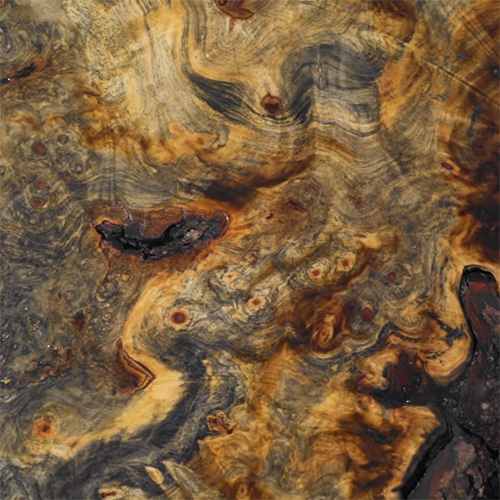Sugar Pine
[Pinus lambertiana]
The world’s largest and tallest Pine species, the average Sugar Pine grows up to 200 feet in height and 10 feet across — with the tallest ever recorded being a majestic, 273-foot-tall specimen found in Yosemite National Park in 2015.
However, unlike other varieties of Pine that look like tall, slender poles with shaggy tops, the Sugar Pine grows thick, massive branches – as long as 60 feet each – from the bottom to the top of its trunk. A colossal tree, it also produces the longest, thickest, heaviest pinecones of any Pine, with each cone often extending more than 2 feet long and weighing a solid pound.
Needless to say, in any its native Western U.S. landscapes, the Sugar Pines is a monstrous tree. Growing naturally from Oregon to Baja California and east to Nevada, the species thrives in higher elevations. Especially in the Cascade and Klamath Mountain ranges of Oregon, Sierra Nevada and Coast ranges in California, and the Sierra de San Pedro Martir in Mexico
But if you want to see a lot of these towering giants, aim for California, where more than 80% of today’s Sugar Pine trees are found. Then make a beeline for the western slopes of the Sierra Nevada Mountains, home to the densest populations of the species.
Living up to 1,000 years, the species was discovered in August 1825 by the botanist/explorer David Douglas – the namesake of the Douglas-fir – who called the Sugar Pine, “the most princely of the genus.”
Based on his accounts, Douglas was guided to a particularly huge specimen by a Native American who knew the trees quite well, since the indigenous people in that part of California had relied on every part of the Sugar Pine for millennia. Including the seeds and bark for food, small roots to make baskets, and gum to repair canoes, as well as fasten arrowheads and feathers to shafts. They also used the leaves and bark for medicinal teas.
In fact, the Sugar Pine played such an integral part in their everyday lives, the Achomawi people of Northeastern California gave the tree a central role in their creation myth. As the story goes, Annikadel, the creator, made the “First People” by dropping Sugar Pine seeds in a place where they could sprout and grow to become the first humans.
But the most highly-prized resource of the tree for local tribes was its delectably sweet sap — which is, no surprise, the source of the Sugar Pine’s common name.
John Muir, the famous naturalist, agreed 100%, preferring the sweet sap of the Sugar Pine to that of Maple syrup. Even more, Muir was so impressed by the amazing species, he described the Sugar Pine as the “King of the Conifers.” A group which, mind you, includes the Giant Sequoia, Coast Redwood, Alaskan Yellow Cypress, Sitka Spruce, Douglas-fir, and Western White Pine.
As with all these extraordinary species, heavy logging of the Sugar Pine began around the time of the California Gold Rush (1848-1855). As a matter of fact, Sutter’s Mill where the mining craze started, was originally built to process Sugar Pine lumber.
Despite being categorized as a softwood, Sugar Pine is a very hard variety of Pine. And though it’s weaker than Southern Yellow Pine, the wood of Sugar Pine is of exceptional quality — lightweight with excellent dimensional stability in large, clear, easily worked pieces. An outstanding combination that has made the species one of the most highly prized lumbers since the late 19th century.
Over time, though, the species has been in slow decline. Despite its rapid growth rate, harvesting of Sugar Pine has far exceeded its regrowth, both historically and today. Even more alarming, the tree faces several environmental threats — forest fires, drought, and the White Pine Blister Rust, a fungus that was accidentally brought to the United States from Europe in 1909. Since then the pathogen has decimated what used to be extensive stands of Sugar Pine, especially in the northern part of its range.
As devastating as the fungal disease has been, severe droughts and fires in the 21st century have ravaged many large Sugar Pine trees, particularly in the Sierra Nevada range. But the good news is that efforts to restore the majestic species, and other White Pine species, are being undertaken by both government and private organizations.
An absolute awe-inspiring tree in the forest, salvaged Sugar Pine wood is equally breathtaking once harvested. While the heartwood is light brown, sometimes with a slightly reddish hue, the sapwood appears pale yellow to nearly white. And you can expect the overall color to age over time to a fine, even pale brown tinged with pink. It features a uniquely straight, uniform grain – even among Pines – that’s amazingly clear and nearly knot-free, and a medium-to-coarse texture.
A longtime favorite for construction lumber, shingles, crates, and boxes, Sugar Pine is now a champion choice for furniture, interior millwork, molding, and musical instrument parts, including piano keys and organ pipes.
Species Distribution:
Western United States
Oregon
California
Nevada
Baja California
Common/Alternative Names:
Sugar Cone Pine
Big Sugar Pine
Great Sugar Pine
Pino de Azucar
Ocote
Sustainability Status:
CITES Appendices: Not listed
IUCN Red List of Threatened Species: Listed as being a species of least concern.
Janka Hardness:
380 lbf
Related Species:
Austrian Pine (Pinus nigra)
Caribbean Pine (Pinus caribaea)
Eastern White Pine (Pinus strobus)
Jack Pine (Pinus banksiana)
Jeffrey Pine (Pinus jeffreyi)
Khasi Pine (Pinus kesiya)
Limber Pine (Pinus flexilis)
Loblolly Pine (Pinus taeda)
Lodgepole Pine (Pinus contorta)
Longleaf Pine (Pinus palustris)
Maritime Pine (Pinus pinaster)
Ocote Pine (Pinus oocarpa)
Patula Pine (Pinus patula)
Pinyon Pine (Pinus edulis)
Pitch Pine (Pinus rigida)
Pond Pine (Pinus serotina)
Ponderosa Pine (Pinus ponderosa)
Radiata Pine (Pinus radiata)
Red Pine (Pinus resinosa)
Sand Pine (Pinus clausa)
Scots Pine (Pinus sylvestris)
Shortleaf Pine (Pinus echinata)
Slash Pine (Pinus elliottii)
Spruce Pine (Pinus glabra)
Sumatran Pine (Pinus merkusii)
Table Mountain Pine (Pinus pungens)
Western White Pine (Pinus monticola)
Virginia Pine (Pinus virginiana)







